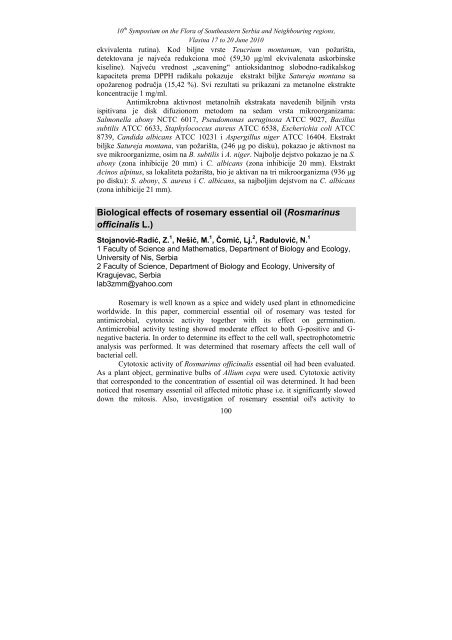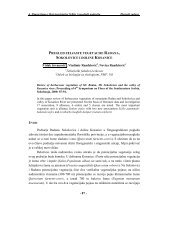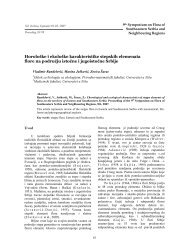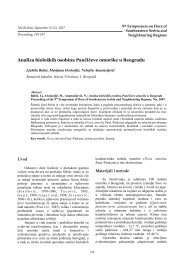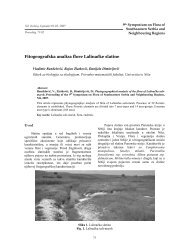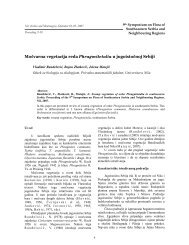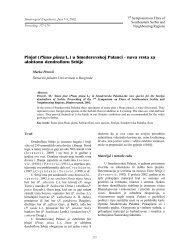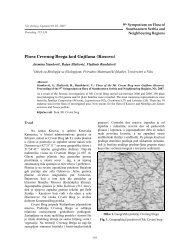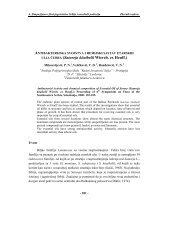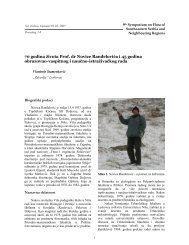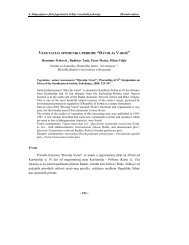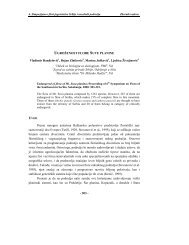10th Symposium on the Flora of Southeastern Serbia and ...
10th Symposium on the Flora of Southeastern Serbia and ...
10th Symposium on the Flora of Southeastern Serbia and ...
Create successful ePaper yourself
Turn your PDF publications into a flip-book with our unique Google optimized e-Paper software.
10 th <str<strong>on</strong>g>Symposium</str<strong>on</strong>g> <strong>on</strong> <strong>the</strong> <strong>Flora</strong> <strong>of</strong> Sou<strong>the</strong>astern <strong>Serbia</strong> <strong>and</strong> Neighbouring regi<strong>on</strong>s,Vlasina 17 to 20 June 2010ekvivalenta rutina). Kod biljne vrste Teucrium m<strong>on</strong>tanum, van požarišta,detektovana je najveća redukci<strong>on</strong>a moć (59,30 μg/ml ekvivalenata askorbinskekiseline). Najveću vrednost „scavening“ antioksidantnog slobodno-radikalskogkapaciteta prema DPPH radikalu pokazuje ekstrakt biljke Satureja m<strong>on</strong>tana saopožarenog područja (15,42 %). Svi rezultati su prikazani za metanolne ekstraktek<strong>on</strong>centracije 1 mg/ml.Antimikrobna aktivnost metanolnih ekstrakata navedenih biljnih vrstaispitivana je disk difuzi<strong>on</strong>om metodom na sedam vrsta mikroorganizama:Salm<strong>on</strong>ella ab<strong>on</strong>y NCTC 6017, Pseudom<strong>on</strong>as aeruginosa ATCC 9027, Bacillussubtilis ATCC 6633, Staphylococcus aureus ATCC 6538, Escherichia coli ATCC8739, C<strong>and</strong>ida albicans ATCC 10231 i Aspergillus niger ATCC 16404. Ekstraktbiljke Satureja m<strong>on</strong>tana, van požarišta, (246 μg po disku), pokazao je aktivnost nasve mikroorganizme, osim na B. subtilis i A. niger. Najbolje dejstvo pokazao je na S.ab<strong>on</strong>y (z<strong>on</strong>a inhibicije 20 mm) i C. albicans (z<strong>on</strong>a inhibicije 20 mm). EkstraktAcinos alpinus, sa lokaliteta požarišta, bio je aktivan na tri mikroorganizma (936 μgpo disku): S. ab<strong>on</strong>y, S. aureus i C. albicans, sa najboljim dejstvom na C. albicans(z<strong>on</strong>a inhibicije 21 mm).Biological effects <strong>of</strong> rosemary essential oil (Rosmarinus<strong>of</strong>ficinalis L.)Stojanović-Radić, Z. 1 , Nešić, M. 1 , Čomić, Lj. 2 , Radulović, N. 11 Faculty <strong>of</strong> Science <strong>and</strong> Ma<strong>the</strong>matics, Department <strong>of</strong> Biology <strong>and</strong> Ecology,University <strong>of</strong> Nis, <strong>Serbia</strong>2 Faculty <strong>of</strong> Science, Department <strong>of</strong> Biology <strong>and</strong> Ecology, University <strong>of</strong>Kragujevac, <strong>Serbia</strong>lab3zmm@yahoo.comRosemary is well known as a spice <strong>and</strong> widely used plant in ethnomedicineworldwide. In this paper, commercial essential oil <strong>of</strong> rosemary was tested forantimicrobial, cytotoxic activity toge<strong>the</strong>r with its effect <strong>on</strong> germinati<strong>on</strong>.Antimicrobial activity testing showed moderate effect to both G-positive <strong>and</strong> G-negative bacteria. In order to determine its effect to <strong>the</strong> cell wall, spectrophotometricanalysis was performed. It was determined that rosemary affects <strong>the</strong> cell wall <strong>of</strong>bacterial cell.Cytotoxic activity <strong>of</strong> Rosmarinus <strong>of</strong>ficinalis essential oil had been evaluated.As a plant object, germinative bulbs <strong>of</strong> Allium cepa were used. Cytotoxic activitythat corresp<strong>on</strong>ded to <strong>the</strong> c<strong>on</strong>centrati<strong>on</strong> <strong>of</strong> essential oil was determined. It had beennoticed that rosemary essential oil affected mitotic phase i.e. it significantly sloweddown <strong>the</strong> mitosis. Also, investigati<strong>on</strong> <strong>of</strong> rosemary essential oil's activity to100


